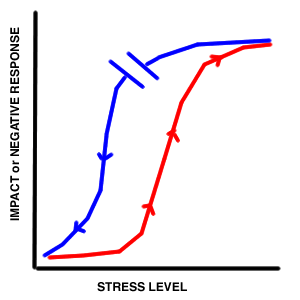threshold-system.html
![]()
It is generally understood that sometimes just a little too much exposure to something (heat, sun, drugs, exhaust) might make a healthy person gets sick. It is also almost intuitive to most people that for that person to recover, they might have to not only stop what they are doing, but take some extra care to get healthy again. For example, even if you are just overly tired, it may take more rest to recover. There are a variety of responses described in toxicology, and I am claiming that these are special cases of the general threshold plus hystersis response. These simpler and specialized cases are described below (Figures 1, 2 and 3). The purpose of this paper is make the case that ecosystem problems, and specifically global climate change, should be addressed as if they are highly uncertain threshold responses with potential hysteresis.
|
|
| Figure 1. Incremental response. A little more or less of the stressor and you get a little more or less of a response. This simple case is also associated with "reversibility" which is what ever you do can be un-done (Control Z). |
|
| Figure 2. Sigmoidal or threshold response. There is a region of low stress that results in very little response, then a region with a high response per increment of stress and finally a third region where the response is at its maximum. The high and low regions of response can be thought of as alternative "states" or different "regimes". The middle region is the area where the stress crosses the threshold and changes the response from one state to the next. The slope of this middle region can vary depending on the sensitivity of the system. |
|
Figure 3. Hysteresis of response. When the stress is increased it may take a higher level to start having a negative impact and, conversely, as the stress may have to be decreased to a much lower level to allow the system to recover to a healthy, unimpacted, state. In this figure the red line is increasing and the blue line is decreasing concentrations. That they don't fall on the same function of stress is the hysteresis.
|
|
Research in ecosystem restoration shows that sometimes decreasing the stress level is not sufficient; it takes some sort of disturbance or extraordinary conditions to cause a shift from the impacted, less healthy regime back to the healthy regime. This is thought to be because each regime has its own set of positive feedback loops that stabilize it and some of these loops have to be disrupted to allow a the healthy state to reassemble itself. For example in Northern European lakes that had become eutrophic because of t This is an important point in considering ecosystem restoration or the remediation of global insults. It may be that not only does the stress have to be removed but the barrier may need to be overcome with some extra effort or targetted outside effort.
|
|
| Figure 5. Hysteresis with a barrier. In the recovery phase there may be a barrier that must be overcome. This barrier will require some sort of disturbance or manipulation. |  |